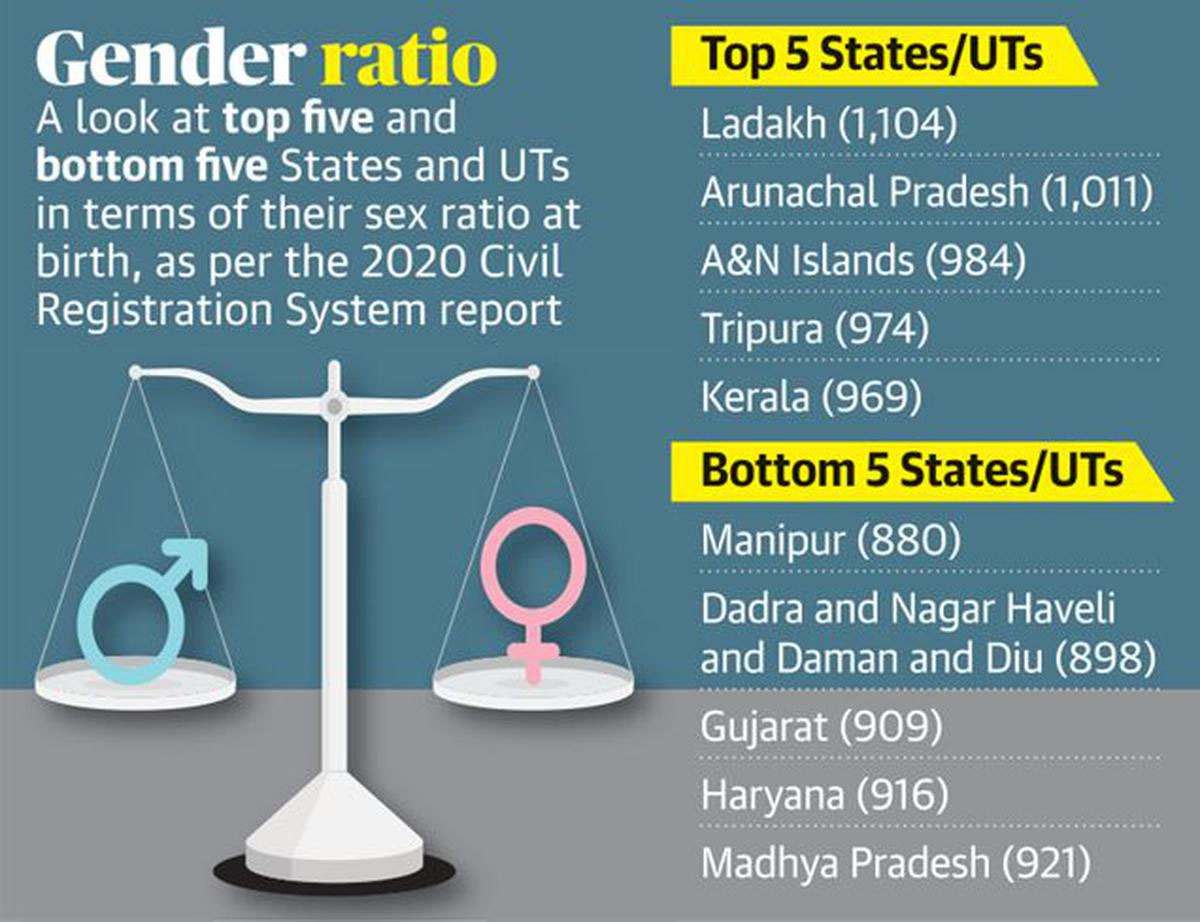India’s Civil Registration System Report | 05 May 2022
For Prelims: Civil Registration System, Registrar General of India, Registration of Births and Death Act
For Mains: Population and Associated Issues
Why in News?
According to the recently released annual report on Vital Statistics based on the 2020 Civil Registration System Report (CRS), the Union Territory of Ladakh recorded the highest sex ratio at birth in the country in 2020.
- The report was published by the Registrar General of India.
- Sex ratio at birth is the number of females born per thousand males. It is an important indicator to map the gender gap of a population.
What is the Registrar General of India?
- The Registrar General of India was founded in 1961 by the Government of India under the Ministry of Home Affairs.
- It arranges, conducts and analyses the results of the demographic surveys of India including the Census of India and Linguistic Survey of India.
- The position of Registrar is usually held by a civil servant holding the rank of Joint Secretary.
- Civil Registration System (CRS) in India is the unified process of continuous, permanent, compulsory and universal recording of the vital events (births, deaths, stillbirths) and characteristics thereof. The data generated through a complete and up-to-date CRS is essential for socio-economic planning.
- Registration of Births and Deaths in India is mandatory with the enactment of Registration of Births and Deaths (RBD), Act 1969 and is done as per the place of occurrence of the event.
- According to the 2020-21 annual report of the Ministry of Home Affairs (MHA), the Central government is planning to revamp the Civil Registration System (CRS) to enable the registration of birth and death in real-time with minimum human interface that will be independent of location.
What is the RBD Act?
- The Registration of Births and Death Act (RBD Act) was enacted in 1969 to promote uniformity and comparability in the registration of births and deaths across the country and compilation of vital statistics based thereon.
- With the enactment of the Act, registration of births, deaths and stillbirths has become mandatory in India.
- The registration of births and deaths in the country is done by the functionaries appointed by the state governments.
- The directorates of Census Operations are the sub-ordinate offices of Office of the Registrar General and these offices are responsible of monitoring the working of the Act in their concerned state and Union Territory.
What are the Highlights of the Report?
- Highest Sex Ratio at Birth (SRB): In 2020, it is reported by Ladakh (1104) followed by Arunachal Pradesh (1011), Andaman & Nicobar Islands (984), Tripura (974), and Kerala (969).
- In 2019, the highest sex ratio at birth was reported by Arunachal Pradesh (1024), followed by Nagaland (1001), Mizoram (975) and A&N Islands (965).
- The information from Maharashtra, Sikkim, Uttar Pradesh and Delhi on sex ratio at birth was “not available.”
- Lowest Sex Ratio at Birth: The top five states that recorded Lowest Sex Ratio at Birth in 2020 are Manipur (880), followed by Dadra and Nagar Haveli and Daman and Diu (898), Gujarat (909), Haryana (916) and Madhya Pradesh (921).
- In 2019, the lowest sex ratio was reported by Gujarat (901), Assam (903), Madhya Pradesh (905) and Jammu & Kashmir (909).
- Birth Rate: States like Nagaland, Puducherry, Telangana, Manipur, Delhi, Arunachal Pradesh, West Bengal, Kerala, Gujarat, Karnataka, Himachal Pradesh, Uttar Pradesh, Assam, Tamil Nadu, Uttarakhand, Maharashtra, Mizoram, and Chandigarh recorded a decrease in the registered birth rate.
- Lakshadweep, Bihar, Haryana, Sikkim, Madhya Pradesh and Rajasthan recorded an increase in the registered birth rate.
- Death Rate: Maharashtra, Gujarat, Andhra Pradesh, Bihar, West Bengal, Nagaland, Haryana, Karnataka, Tamil Nadu, Sikkim, Punjab, Madhya Pradesh, Odisha, Rajasthan, Andaman & Nicobar Island and Assam recorded an increase in death rate in 2020 with respect to 2019.
- Bihar saw the maximum increase in the death rate with 18.3% followed by Maharashtra with 16.6% and Assam with 14.7%.
- Meanwhile, states like Manipur, Chandigarh, Telangana, Uttar Pradesh, Uttarakhand, Puducherry, Arunachal Pradesh, and Kerala saw a decrease in death rates in 2020 with respect to 2019.
- Infant Deaths: The report noted that 1,43,379 infant deaths were registered in 2020 and the share of rural area was only 23.4%, while that of the urban area was 76.6% of total registered infant deaths.
- Non-registration of infant deaths in rural areas was a cause of concern, due to non-reporting of infant deaths to the Registrars, especially in case of domiciliary events.

